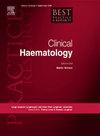非霍奇金淋巴瘤的过继细胞治疗
IF 2
4区 医学
Q3 HEMATOLOGY
引用次数: 0
摘要
淋巴瘤是一组处于不同成熟阶段的B、T或nk淋巴样细胞的恶性增生。虽然它们主要发生在淋巴结或淋巴组织,但也可能涉及骨髓、血液或其他器官。尽管治疗取得了进展,但许多患者复发或发展为难治性疾病,促使新疗法的发展。最具前景的创新之一是嵌合抗原受体(CAR) T细胞疗法,它通过对患者的T淋巴细胞进行基因修饰,以更好地靶向和杀死癌细胞。目前,所有fda批准的CAR- t细胞疗法靶向CD19(一种表达在B淋巴细胞上的表面蛋白),然而,正在进行的研究包括靶向新靶点或靶向多种抗原的CAR- t。本研究旨在全面概述已批准和新兴car - t治疗淋巴瘤的临床应用和治疗效果。本文章由计算机程序翻译,如有差异,请以英文原文为准。
Adoptive cellular therapies in non-Hodgkin lymphomas
Lymphomas are a group of malignant proliferations of B, T or NK-lymphoid cells at different stages of maturation. While they primarily occur in lymph nodes or lymphatic tissues, they can also involve bone marrow, blood, or other organs. Despite advances in treatment, many patients experience relapse, or develop refractory disease, prompting the development of new therapies. One of the most promising innovations is represented by chimeric antigen receptors (CAR) T-cell therapy, that works by genetically modifying a patient's T lymphocytes to better target and kill their cancer cells. Currently, all FDA-approved CAR T-cell therapies target CD19 (a surface protein expressed on B lymphocytes), however, ongoing research includes CAR-Ts that address novel targets or target multiple antigens. This study aims to provide a comprehensive overview on the clinical use and therapeutic efficacy of both approved and emerging CAR-Ts in the treatment of lymphoma.
求助全文
通过发布文献求助,成功后即可免费获取论文全文。
去求助
来源期刊
CiteScore
4.20
自引率
0.00%
发文量
42
审稿时长
35 days
期刊介绍:
Best Practice & Research Clinical Haematology publishes review articles integrating the results from the latest original research articles into practical, evidence-based review articles. These articles seek to address the key clinical issues of diagnosis, treatment and patient management. Each issue follows a problem-orientated approach which focuses on the key questions to be addressed, clearly defining what is known and not known, covering the spectrum of clinical and laboratory haematological practice and research. Although most reviews are invited, the Editor welcomes suggestions from potential authors.

 求助内容:
求助内容: 应助结果提醒方式:
应助结果提醒方式:


